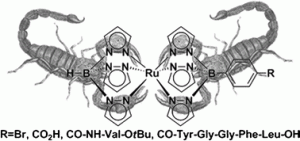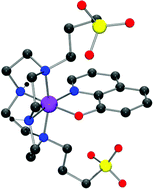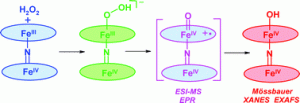Do you work in the field of inorganic materials and solid state chemistry or perhaps you just have an interest in the area? If so, you should check out the following selection of Dalton Transactions articles from the area of inorganic materials and solid state chemistry which you can access for FREE until the 22nd December 2010:
Use of plasma-activated gases in synthesis of solid-state nitrides
Grigori V. Vajenine
Dalton Trans., 2010, 39, 6013-6017 DOI: 10.1039/C000361A
Ferroelectric and ferromagnetic properties of Pb(Ti0.8Fe0.2)O3−δ thin film
Ce Sun, Jinguo Wang, Huajun Kang, Jun Chen, Moon J. Kim and Xianran Xing
Dalton Trans., 2010, 39, 9952-9955 DOI: 10.1039/C0DT00681E
Thermal spin-crossover in the [M3Zn6Cl6L12] (M = Zn, FeII; L = 5,6-dimethoxy-1,2,3-benzotriazolate) system: structural, electrochemical, Mössbauer, and UV-Vis spectroscopic studies
Shyam Biswas, Markus Tonigold, Harald Kelm, Hans-Jörg Krüger and Dirk Volkmer
Dalton Trans., 2010, 39, 9851-9859 DOI: 10.1039/C0DT00556H
Unique assembly of low-dimensional viologen iodoplumbates and their improved semiconducting properties
Yang Chen, Zi-Ou Wang, Zhou Yang, Zhi-Gang Ren, Hong-Xi Li and Jian-Ping Lang
Dalton Trans., 2010, 39, 9476-9479 DOI: 10.1039/C0DT00757A
Facile hydrothermal synthesis and observation of bubbled growth mechanism in nano-ribbons aggregated microspherical Covellite blue-phosphor
Nirupam Banerjee and S. B. Krupanidhi
Dalton Trans., 2010, 39, 9789-9793 DOI: 10.1039/C0DT00386G
Photochemical behavior of (diphosphine)(η2-tolane)Pt0 complexes. Part A: Experimental considerations in solution and in the solid state
Thomas Weisheit, Daniel Escudero, Holm Petzold, Helmar Görls, Leticia González and Wolfgang Weigand
Dalton Trans., 2010, 39, 9493-9504 DOI: 10.1039/B925562A
Increasing the dimensionality of hybrid vanadium oxyfluorides using ionothermal synthesis
Farida Himeur, Phoebe K. Allan, Simon J. Teat, Richard J. Goff, Russell E. Morris and Philip Lightfoot
Dalton Trans., 2010, 39, 6018-6020 DOI: 10.1039/C000318B
Factors controlling material deposition in the CVD of nickel sulfides, selenides or phosphides from dichalcogenoimidodiphosphinato complexes: deposition, spectroscopic and computational studies
Arunkumar Panneerselvam, Ganga Periyasamy, Karthik Ramasamy, Mohammad Afzaal, Mohammad A. Malik, Paul O’Brien, Neil A. Burton, John Waters and Bart E. van Dongen
Dalton Trans., 2010, 39, 6080-6091 DOI: 10.1039/C002928A
Topotactic reduction as a synthetic route for the preparation of low-dimensional Mn(II) oxide phases: The structure and magnetism of LaAMnO4-x (A = Sr, Ba)
Helen J. Kitchen, Ian Saratovsky and Michael A. Hayward
Dalton Trans., 2010, 39, 6098-6105 DOI: 10.1039/B923966A
Syntheses and characterization of some solid-state actinide (Th, U, Np) compounds
Daniel E. Bugaris and James A. Ibers
Dalton Trans., 2010, 39, 5949-5964 DOI: 10.1039/B927026D
You may also find it interesting to look at some of the recent Dalton Transactions topical themed issues from your field:
Highlighting and celebrating the diversity of modern synthetic solid state chemistry.
 Thermoelectric Materials – Issue 4, 2010
Thermoelectric Materials – Issue 4, 2010
Guest Editor: Andrei Shevelkov, Moscow State University
The development of thermoelectric materialsis surveyed in the selection of papers written by experts in the field for this themed issue of Dalton Transactions.
 Catalytic alkylation of aryl Grignard reagents by iron(III) amine-bis(phenolate) complexes
Catalytic alkylation of aryl Grignard reagents by iron(III) amine-bis(phenolate) complexes 










![[Fe(dppTTF)2][Ni(mnt)2]2(BF4)·PhCN](https://blogs.rsc.org/dt/files/2010/11/c0dt01092h-ga-300x187.gif)
![The incorporation of [Ru(p-cymene)] complexes into the ferritin cavity without causing degradation of its cage cavity](https://blogs.rsc.org/dt/files/2010/11/c0dt00955e-ga1.gif) Incorporation of organometallic Ru complexes into apo-ferritin cage
Incorporation of organometallic Ru complexes into apo-ferritin cage
 Syntheses of 8-quinolinolatocobalt(III) complexes containing cyclen based auxiliary ligands as models for hypoxia-activated prodrugs
Syntheses of 8-quinolinolatocobalt(III) complexes containing cyclen based auxiliary ligands as models for hypoxia-activated prodrugs trans-FeII(H)2(diphosphine)(diamine) complexes as alternative catalysts for the asymmetric hydrogenation of ketones? A DFT study
trans-FeII(H)2(diphosphine)(diamine) complexes as alternative catalysts for the asymmetric hydrogenation of ketones? A DFT study High-valent diiron species generated from N-bridged diiron phthalocyanine and H2O2
High-valent diiron species generated from N-bridged diiron phthalocyanine and H2O2 Frontiers of synthetic solid state chemistry – Issue 26, 2010
Frontiers of synthetic solid state chemistry – Issue 26, 2010

![Diagram showing the [Bi3GaS5]2+ cation and the trimeric star-shaped [Ga3Cl10]− anion](https://blogs.rsc.org/dt/files/2010/11/c0dt00985g-ga1-300x135.gif)
